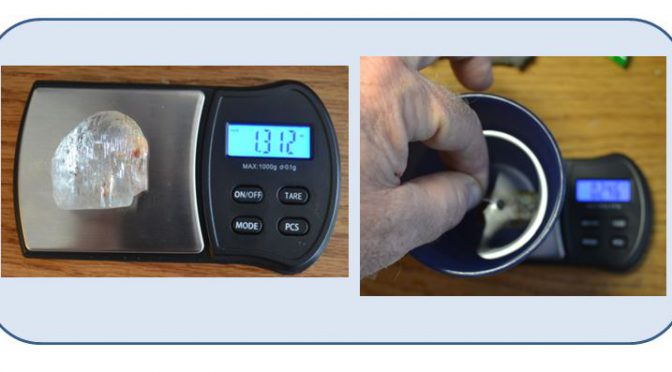
This note was published in the the Sept. 2017 WCGMC Newsletter
How do you try to identify an unknown mineral? If you are like most folks you start with color, which can help, but can also mislead. Trace elements and other types of inclusions can alter the color or many minerals. Does it have crystal faces? Maybe, but often not. Can you see a cleavage direction? Can you even distinguish crystal faces from cleavage? Calcite has rhombohedral cleavage, galena is cubic, but then fluorite is a cubic crystal with octahedral cleavage. That isn’t even fair. Luster helps with metallic minerals. Hardness can be helpful, but no one wants to scratch a prize find.
What about density, or more accurately specific gravity (sg). If it is magnetite or galena you can tell it is dense when you pick it up, but what about other minerals with specific gravity closer to the common minerals? Or heavy minerals that are not magnetic? Is there a method to easily measure specific gravity?
Continue reading Measuring Specific Gravity →

For the second consecutive year, members of Wayne County Gem and Mineral Club joined with the Niagara Peninsula Geological Society for a several day trip to mineral sites in Ontario. We thank Ashley Pollock for organizing the trip and I thank Ashley for writing this short summary of one of the sites we visited and allowing me to publish it in the September, 2017 WCGMC newsletter and also this this blog.
It rained and then it stopped and then it rained again as we drove north to start our week long summer collecting trip. But when we met our Wayne County Club friends at our first collecting stop along the French River south of Sudbury, the clouds had parted and the week of fun began.
The Rutter Pluton is a nepheline-syenite intrusion within/ straddling the border of the Grenville Front Tectonic Zone (GFTZ) of the Grenville Province. The 10 km long, 2 km wide igneous body is dated at 975 million years. Like much of the Precambrian terrain in Ontario, the igneous rocks have been metamorphosed to a gneissic texture. Mineralogically, the pluton consists of nepheline, albite (plagioclase feldspar), potassium-feldspar, and biotite mica. Quartz is absent.
Continue reading Rutter Pluton, French River, Ontario →
Retired, collecting minerals and stamps, growing flowers and vegetables, and when the spirit moves, toying with technology

